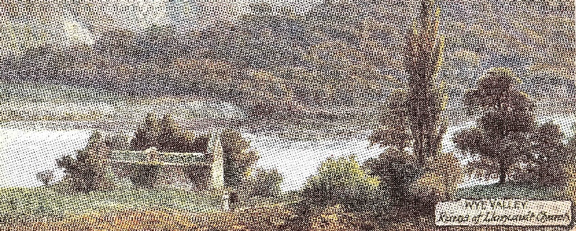‘The situation, on one of the crooks of the Wye, and just above the river is romantic in the extreme … Access is only possible by boat, or by a rough way known as the Fisherman’s Path, along the front of the cliffs.’
Enclosed within a sweeping bend of the River Wye and bordered by steep limestone cliffs, Lancaut is, quite literally, a lost place. The ruins of St James Church are all that remain of a medieval village, a silent reminder that for centuries people farmed, fished and worshipped here. There has been a place of worship here since at least 625 AD, making it one of the earliest sites of Christian activity in the Wye Valley. The original church was dedicated to St Cewydd a Welsh saint. He may have been a monk who helped spread Christianity inland along the Wye from the centre of religious learning at Llancarfon in the Vale of Glamorgan. Alternatively, Christianity may have expanded down the Wye from Archenfield (in Herefordshire), which had been a stronghold of Celtic Christianity since Roman times. These churches were often built in isolated locations, beside water and a day’s walk apart. Almost completely surrounded by the river, the Lancaut peninsular was an ideal location. Historical references suggest there may have been an early monastic community here, but recent archaeological investigations have raised more questions than answers, although numerous burials have been identified around the church.


Records show that the Wye provided an easy route inland for Viking raiders, who in 914 took the Bishop of Archenfield prisoner for a ransom of £400! The Vikings may have destroyed the original church, as the one you see today was probably built by the Lord of Chepstow Castle around 1067 and given its dedication to St James at this time. The church became the focal point of the medieval village which grew up around it. It is difficult to know if the village was English or Welsh. Its name suggests it was Welsh – ‘Llan’ is the old Welsh word for a church or land consecrated for burials – although it is on the wrong side of the river, which forms today’s boundary between England and Wales.
We don’t know why the village died. Perhaps life on this isolated promontory became too much of a struggle. As the number of villagers declined so did the services in the church and from the 1750s only twelve services a year were held. But the church remained a ‘favourite resort’ well into the 19th century when Eleanor Ormerod described how the congregation were ‘packed as tightly as could be managed, so that we all had to get up and sit down together’. Eleanor’s father, George Ormerod was a local antiquary who recorded details of the church in the 1840s and 50s – its tall pulpit, box pews and tiny bellcot. In 1865 the church was finally abandoned, the furnishings removed and the roof dismantled.